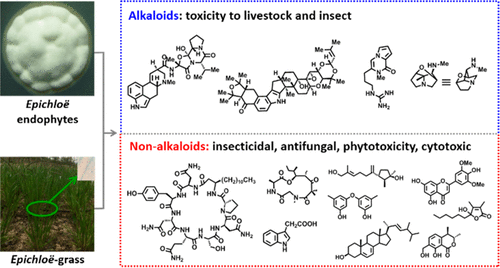当前位置:
X-MOL 学术
›
J. Agric. Food Chem.
›
论文详情
Our official English website, www.x-mol.net, welcomes your
feedback! (Note: you will need to create a separate account there.)
Do Epichloë Endophytes and Their Grass Symbiosis Only Produce Toxic Alkaloids to Insects and Livestock?
Journal of Agricultural and Food Chemistry ( IF 5.7 ) Pub Date : 2020-01-22 , DOI: 10.1021/acs.jafc.9b06614 Qiu-Yan Song 1 , Fan Li 1 , Zhi-Biao Nan 1 , Jeffrey A Coulter 2 , Wen-Jun Wei 3
Journal of Agricultural and Food Chemistry ( IF 5.7 ) Pub Date : 2020-01-22 , DOI: 10.1021/acs.jafc.9b06614 Qiu-Yan Song 1 , Fan Li 1 , Zhi-Biao Nan 1 , Jeffrey A Coulter 2 , Wen-Jun Wei 3
Affiliation

|
Epichloë endophytes in forage grasses have attracted widespread attention and interest of chemistry researchers as a result of the various unique chemical structures and interesting biological activities of their secondary metabolites. This review describes the diversity of unique chemical structures of taxa from Epichloë endophytes and grass infected with Epichloë endophytes and demonstrates their reported biological activities. Until now, nearly 160 secondary metabolites (alkaloids, peptides, indole derivatives, pyrimidines, sesquiterpenoids, flavonoids, phenol and phenolic acid derivatives, aliphatic metabolites, sterols, amines and amides, and others) have been reported from Epichloë endophytes and grass infected with Epichloë endophytes. Among these, non-alkaloids account for half of the population of total metabolites, indicating that they also play an important role in Epichloë endophytes and grass infected with Epichloë endophytes. Also, a diverse array of secondary metabolites isolated from Epichloë endophytes and symbionts is a rich source for developing new pesticides and drugs. Bioassays disclose that, in addition to toxic alkaloids, the other metabolites isolated from Epichloë endophytes and symbionts have notable biological activities, such as antifungal, anti-insect, and phytotoxic activities. Accordingly, the biological functions of non-alkaloids should not be neglected in the future investigation of Epichloë endophytes and symbionts.
中文翻译:

Epichloë内生菌及其草共生只会对昆虫和牲畜产生有毒生物碱吗?
饲草中的表皮内生菌因其次生代谢产物的各种独特化学结构和有趣的生物学活性而引起了化学研究者的广泛关注和兴趣。这篇综述描述了内生附生植物和被内生附生植物感染的草类群的独特化学结构的多样性,并证明了它们的生物学活性。到目前为止,据报道,表皮内生菌和被表皮lo虫感染的草已报告了近160种次生代谢物(生物碱,肽,吲哚衍生物,嘧啶,倍半萜类,黄酮,酚和酚酸衍生物,脂肪族代谢物,固醇,胺和酰胺等)。内生菌。其中,非生物碱占总代谢物总数的一半,这表明它们在Epichloë内生菌和感染Epichloë内生菌的草中也起着重要作用。同样,从上生内生真菌和共生菌中分离出来的各种次级代谢产物也是开发新农药和药物的丰富资源。生物测定法表明,除了有毒生物碱以外,从Epichloë内生菌和共生菌中分离出的其他代谢物还具有显着的生物学活性,例如抗真菌,抗昆虫和植物毒性活性。因此,非生物碱的生物学功能在以后的上Epi内生菌和共生体的研究中不应被忽略。从Epichloë内生菌和共生菌中分离出来的各种次级代谢产物是开发新农药和药物的丰富资源。生物测定法表明,除了有毒生物碱以外,从Epichloë内生菌和共生菌中分离出的其他代谢物还具有显着的生物学活性,例如抗真菌,抗昆虫和植物毒性活性。因此,非生物碱的生物学功能在以后的上Epi内生菌和共生体的研究中不应被忽略。从Epichloë内生菌和共生菌中分离出来的各种次级代谢产物是开发新农药和药物的丰富资源。生物测定法表明,除了有毒生物碱以外,从Epichloë内生菌和共生菌中分离出的其他代谢物还具有显着的生物学活性,例如抗真菌,抗昆虫和植物毒性活性。因此,非生物碱的生物学功能在今后对上Epi内生菌和共生体的研究中不应忽略。
更新日期:2020-01-23
中文翻译:

Epichloë内生菌及其草共生只会对昆虫和牲畜产生有毒生物碱吗?
饲草中的表皮内生菌因其次生代谢产物的各种独特化学结构和有趣的生物学活性而引起了化学研究者的广泛关注和兴趣。这篇综述描述了内生附生植物和被内生附生植物感染的草类群的独特化学结构的多样性,并证明了它们的生物学活性。到目前为止,据报道,表皮内生菌和被表皮lo虫感染的草已报告了近160种次生代谢物(生物碱,肽,吲哚衍生物,嘧啶,倍半萜类,黄酮,酚和酚酸衍生物,脂肪族代谢物,固醇,胺和酰胺等)。内生菌。其中,非生物碱占总代谢物总数的一半,这表明它们在Epichloë内生菌和感染Epichloë内生菌的草中也起着重要作用。同样,从上生内生真菌和共生菌中分离出来的各种次级代谢产物也是开发新农药和药物的丰富资源。生物测定法表明,除了有毒生物碱以外,从Epichloë内生菌和共生菌中分离出的其他代谢物还具有显着的生物学活性,例如抗真菌,抗昆虫和植物毒性活性。因此,非生物碱的生物学功能在以后的上Epi内生菌和共生体的研究中不应被忽略。从Epichloë内生菌和共生菌中分离出来的各种次级代谢产物是开发新农药和药物的丰富资源。生物测定法表明,除了有毒生物碱以外,从Epichloë内生菌和共生菌中分离出的其他代谢物还具有显着的生物学活性,例如抗真菌,抗昆虫和植物毒性活性。因此,非生物碱的生物学功能在以后的上Epi内生菌和共生体的研究中不应被忽略。从Epichloë内生菌和共生菌中分离出来的各种次级代谢产物是开发新农药和药物的丰富资源。生物测定法表明,除了有毒生物碱以外,从Epichloë内生菌和共生菌中分离出的其他代谢物还具有显着的生物学活性,例如抗真菌,抗昆虫和植物毒性活性。因此,非生物碱的生物学功能在今后对上Epi内生菌和共生体的研究中不应忽略。











































 京公网安备 11010802027423号
京公网安备 11010802027423号